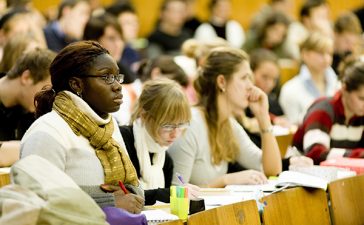With roughly half of the world’s population out of school due to COVID-19 mitigation measures, the pandemic has resulted in a rapid shift to online education. However, many universities are focusing on surviving this temporary shift, rather than building sustainable ways to promote community within social distancing that can outlast COVID-19.
As a result, community building comes second to transitioning curriculum online or managing the logistics surrounding online class facilitation. But even the most successful distance education programmes have drop-out rates that are 10% to 20% higher than traditional education, which is primarily the result of a lack of student engagement and community building platforms, and overarching feelings of isolation.
Instead of just accepting social distancing and self-isolation as a reality of COVID-19, educators have the opportunity to utilise these as tools for engaging in authentic discussions and promoting a more engaged and inclusive student body. As a result, educators not only build student support and community systems in this new, temporary reality, but also build stronger communities in social distancing that can thrive after students return for their classes in person.
From my experience as both an online doctoral student and an educator amidst the COVID-19 shift to online classes, below are some of the strategies that I have found effective in building stronger university communities.
Humanise the classroom experience
Community and socialisation do not only occur outside the classroom and educators can take intentional steps to model their own vulnerability and humanise the classroom experience in order to promote increased student engagement. In doing so, students also demonstrate greater persistence in their education. A few specific actions educators can take to humanise their online classes include:
• Check-in first: Begin class with a check-in, where faculty ask students how they are doing. Faculty can use this as an opportunity to model their own uncertainties and vulnerability during this time as well. For larger lecture-style classes, faculty can rotate through the student roster and have a few students share at the beginning of each class.
• Publish your faculty profile: Include a personalised faculty profile with a photo on the course learning platform. The profile can be different from a professional biography and include more personalised information about the faculty member. In doing so, this builds more trust and rapport between faculty and students.
• Disclose personal information: Throughout class, faculty should make a more intentional effort to share personal anecdotes and experiences within the academic content. When faculty model this behaviour, students are more likely to reciprocate, request support outside of the classroom and maintain trust with their faculty and peers.
• One-on-one student follow-ups: Faculty should make a more intentional effort to follow up with students one-on-one. In online settings, students are less likely to seek help from faculty, which means that faculty need to initiate these follow-ups in order to strengthen community and trust.
Ongoing small group activities
While small group activities may be common practice in traditional classroom settings, they are often forgotten in the transition to online learning. However, during times of isolation, these platforms for student engagement need to be overemphasised rather than reduced or eliminated. When larger communities are broken down into smaller groups, the overall community, as well as student learning outcomes and creativity, are strengthened.
Furthermore, not only do small group activities lead to learning communities and give students a platform to discuss questions about course material, but they also help students strengthen peer relationships and build connections within social distancing in an academically productive way.
To facilitate more impactful small group activities, faculty should explore the features on their learning platforms that allow for smaller group engagement and utilise them on a regular basis. For example, Zoom Breakout Rooms allow faculty to either pre-identify or randomly assign small groups and then monitor the discussions within each group.
Following these small group activities, faculty should solicit feedback from students to identify other ways to use small groups as a platform for building community. By engaging in small group activities and soliciting feedback from students, students and faculty become both leaders and active participants within their online academic communities.
Create online coffee shops
As faculty deliver rigorous curriculum and academic content requirements, there likely isn’t enough time during the regular class period to engage in more personal discussions with students. However, faculty can still play a role in building a social community among students outside the classroom as a way to further build trust and engagement with students.
Ultimately, building social community and connection improves overall student engagement and persistence in their education. One way this can be done is by hosting virtual coffee shops for students and faculty to engage with one another, celebrate their accomplishments and support each other in their challenges.
By arranging loosely structured, optional platforms for social networking and connectivity, faculty are ultimately promoting their students’ overall academic engagement and perseverance in their learning despite isolation. Not only does this build trust and outlets for social connectivity for students while in isolation, but it also builds a strong foundation of community that can be further expanded upon after the COVID-19 pandemic ends.
While many of these ways of building community are common in traditional classroom settings, they are easy to neglect when conducting classes online. This holds particularly true when the university’s focus is primarily on surviving the shift to online education as a temporary solution, rather than strengthening the existing community in a way that aligns with and outlasts the pandemic.
With the abrupt shift from in-person connection to isolation and online learning, students need more community-building and engagement platforms than ever before. Faculty play a key role in providing this. Once we shift our mindset to seeing this as an opportunity to build healthy foundations for community and engagement, COVID-19 becomes an opportunity to improve learning and student engagement long term, rather than simply managing a temporary bump in the road.
Kara Neil is head of academics and lecturer at Vatel Hotel and Tourism Business School – Rwanda campus – and a Doctor of Education candidate at the University of Liverpool, United Kingdom







